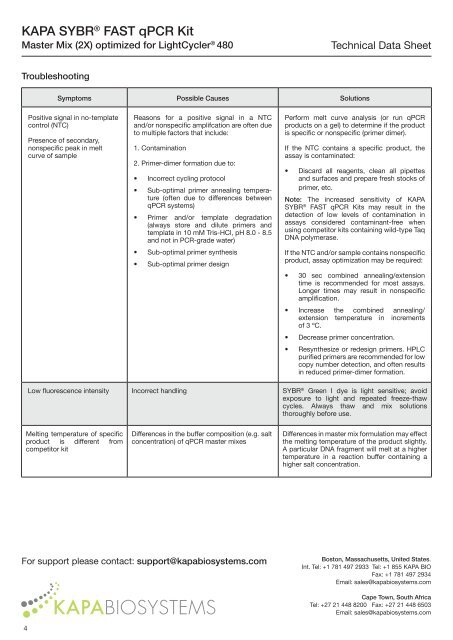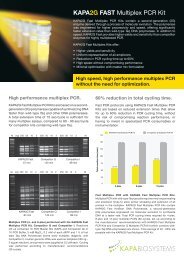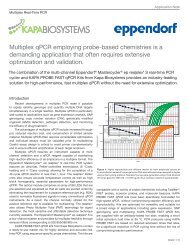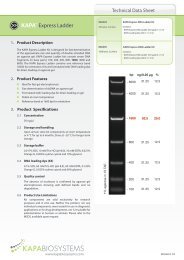KAPA SYBR® FAST qPCR Kit - Kapa Biosystems
KAPA SYBR® FAST qPCR Kit - Kapa Biosystems
KAPA SYBR® FAST qPCR Kit - Kapa Biosystems
You also want an ePaper? Increase the reach of your titles
YUMPU automatically turns print PDFs into web optimized ePapers that Google loves.
<strong>KAPA</strong> SYBR ® <strong>FAST</strong> <strong>qPCR</strong> <strong>Kit</strong><br />
Master Mix (2X) optimized for LightCycler ® 480<br />
Troubleshooting<br />
4<br />
Symptoms Possible Causes Solutions<br />
Positive signal in no-template<br />
control (NTC)<br />
Presence of secondary,<br />
nonspecific peak in melt<br />
curve of sample<br />
Reasons for a positive signal in a NTC<br />
and/or nonspecific amplifcation are often due<br />
to multiple factors that include:<br />
1. Contamination<br />
2. Primer-dimer formation due to:<br />
• Incorrect cycling protocol<br />
• Sub-optimal primer annealing temperature<br />
(often due to differences between<br />
<strong>qPCR</strong> systems)<br />
• Primer and/or template degradation<br />
(always store and dilute primers and<br />
template in 10 mM Tris-HCl, pH 8.0 - 8.5<br />
and not in PCR-grade water)<br />
• Sub-optimal primer synthesis<br />
• Sub-optimal primer design<br />
For support please contact: support@kapabiosystems.com<br />
Technical Data Sheet<br />
Perform melt curve analysis (or run <strong>qPCR</strong><br />
products on a gel) to determine if the product<br />
is specific or nonspecific (primer dimer).<br />
If the NTC contains a specific product, the<br />
assay is contaminated:<br />
• Discard all reagents, clean all pipettes<br />
and surfaces and prepare fresh stocks of<br />
primer, etc.<br />
Note: The increased sensitivity of <strong>KAPA</strong><br />
SYBR ® <strong>FAST</strong> <strong>qPCR</strong> <strong>Kit</strong>s may result in the<br />
detection of low levels of contamination in<br />
assays considered contaminant-free when<br />
using competitor kits containing wild-type Taq<br />
DNA polymerase.<br />
If the NTC and/or sample contains nonspecific<br />
product, assay optimization may be required:<br />
• 30 sec combined annealing/extension<br />
time is recommended for most assays.<br />
Longer times may result in nonspecific<br />
amplification.<br />
• Increase the combined annealing/<br />
extension temperature in increments<br />
of 3 ºC.<br />
• Decrease primer concentration.<br />
• Resynthesize or redesign primers. HPLC<br />
purified primers are recommended for low<br />
copy number detection, and often results<br />
in reduced primer-dimer formation.<br />
Low fluorescence intensity Incorrect handling SYBR ® Green I dye is light sensitive; avoid<br />
exposure to light and repeated freeze-thaw<br />
cycles. Always thaw and mix solutions<br />
thoroughly before use.<br />
Melting temperature of specific<br />
product is different from<br />
competitor kit<br />
Differences in the buffer composition (e.g. salt<br />
concentration) of <strong>qPCR</strong> master mixes<br />
Differences in master mix formulation may effect<br />
the melting temperature of the product slightly.<br />
A particular DNA fragment will melt at a higher<br />
temperature in a reaction buffer containing a<br />
higher salt concentration.<br />
Boston, Massachusetts, United States.<br />
Int. Tel: +1 781 497 2933 Tel: +1 855 <strong>KAPA</strong> BIO<br />
Fax: +1 781 497 2934<br />
Email: sales@kapabiosystems.com<br />
Cape Town, South Africa<br />
Tel: +27 21 448 8200 Fax: +27 21 448 6503<br />
Email: sales@kapabiosystems.com










